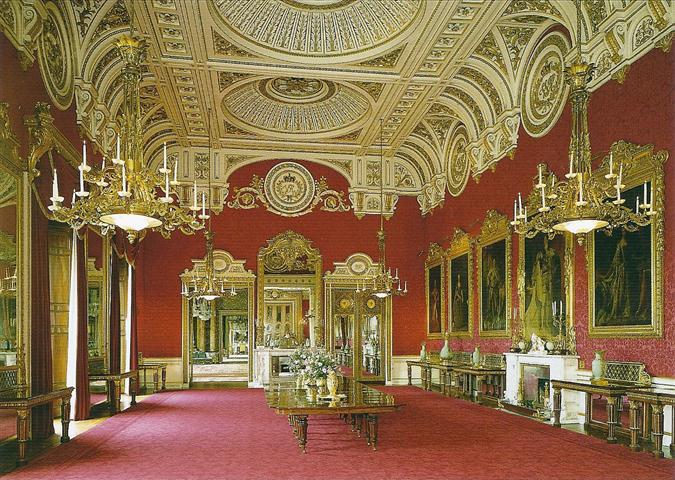 All Fired Up Ceramics Cafe
All Fired Up Ceramics Cafe All Hallows Brass Rubbing Centre
All Hallows Brass Rubbing Centre Bank of England Museum
Bank of England Museum Banqueting House
Banqueting House Barbican Art Gallery
Barbican Art Gallery Buckingham Palace Tour
Buckingham Palace Tour Chapel Royal
Chapel Royal Clarence House
Clarence House Coram's Fields
Coram's Fields Florence Nightingale Museum
Florence Nightingale Museum Goldsmiths' Hall
Goldsmiths' Hall HM Tower of London
HM Tower of London London City Sightseeing - See the best by bus
London City Sightseeing - See the best by bus London Duck Tours
London Duck Tours London RIB Voyages
London RIB Voyages Museum of London
Museum of London Roman London's Amphitheatre
Roman London's Amphitheatre St Bartholomew's Museum
St Bartholomew's Museum St Paul's Cathedral
St Paul's Cathedral The Monument
The Monument
Today Buckingham Palace is The Queen's official residence. Although in use for the many official events and receptions held by The Queen, areas of Buckingham Palace are opened to visitors on a regular basis.
State Rooms
The term ‘State Rooms’ is applied to those rooms that were designed and built as the public rooms of the Palace, in which monarchs receive, reward and entertain their subjects and visiting dignitaries. Today the State Rooms at Buckingham Palace are used extensively by The Queen and members of the Royal Family to receive and entertain their guests on State, ceremonial and official occasions.
The Palace's nineteen State Rooms predominantly reflect the taste George IV (r.1820-30), who commissioned the architect John Nash to transform what had previously been known as Buckingham House into a grand palace. Many of the pieces of furniture, sparkling chandeliers, candelabra and other works of art in these rooms were bought or made for Carlton House, George IV's London home when he was Prince of Wales. Today the State Rooms are furnished with many of the greatest treasures from the Royal Collection, including paintings by Van Dyck and Canaletto, sculpture by Canova, exquisite pieces of Sèvres porcelain, and some of the finest English and French furniture in the world.
Many of the other State Rooms also have particular uses today. It is in the Throne Room, for example, that The Queen, on very special occasions like Jubilees, receives loyal addresses. On 29 April 2011 this room was the setting for the formal photographs following the wedding of The Duke and Duchess of Cambridge. In the Music Room, guests are presented to The Queen, The Duke of Edinburgh and the visiting Head of State on the occasion of a State visit. The White Drawing Room, perhaps the grandest of all the State Rooms, serves as a royal reception room for The Queen and members of the Royal Family to gather before official occasions.
Changing the Guard
Changing the Guard at Buckingham Palace encompasses colourful spectacle and British pageantry. The ceremony lasts about 45 minutes and usually takes place daily at 11:30 from May until the end of July and on alternate days for the rest of the year, weather permitting. Please see the provisional schedule below.
The privilege of guarding the Sovereign traditionally belongs to the Household Troops, better known as ‘the Guards’, who have carried out this duty since 1660. For operational and other reasons, this privilege is periodically extended to other regiments of the British Army. The Guards consist of five infantry regiments - the Grenadier, Coldstream, Scots, Irish and Welsh Guards - and two regiments of the Household Cavalry – the Life Guards and Blues and Royals. Most of the Guards will have seen action overseas.
During the Changing the Guard ceremony, also known as ‘Guard Mounting’, one regiment takes over from another. The Queen’s Guard consists of the St James’s Palace and Buckingham Palace detachments. The New Guard, who during the course of the ceremony become The Queen’s Guard, march to Buckingham Palace from Wellington Barracks.
The Picture Gallery
The 47-metre room was designed as a setting for the King’s magnificent picture collection. The theme of painting is echoed in the Picture Gallery’s four marble chimneypieces.
No Comments Yet - Why not be the first to leave a comment
Every effort is made to make sure that all the information is correct but we strongly recommend that you call Buckingham Palace Tour before you set off on your day out to confirm opening times and admission prices.
Please also note that the position on Google maps for Buckingham Palace Tour is a rough estimate using their postcode in the database and might be slightly out.
It may also be worth clicking the web link for Buckingham Palace Tour to see if there are any special events coming up or currently on.